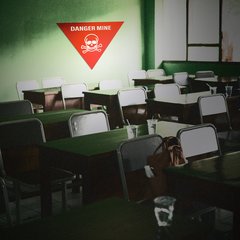School, food, transport – Landmines take away lives and so much more
Conflicts end, but the landmines and other explosive ordnance they leave behind can be devastating and leave lasting damage. The damage is not limited to the communities affected by these weapons, it sets off a chain reaction of far-reaching impact.
What would your life be like if the local supermarket shelves were bare because shipments were blocked and farm fields littered with landmines? How would you decide whether to stop your children’s education or to send them to school knowing that explosive ordnance (EO) had been found on the way? Would you and your partner take different routes to work to increase the likelihood that one of you would be safe if there were an explosion on the commute?
For over 60 million people affected by landmines, cluster munitions and other explosive ordnance around the world, these questions aren’t hypothetical. They’re part of daily life. Humanitarian deminers are working in dozens of countries, removing the mines and other EO and removing the barriers to safety, human rights, and sustainable development that go with them.
Food security
Though it’s not likely to be on your mind as you shop for bread or vegetables, mines can pose major problems for food security. This can be because farmland is unsafe to cultivate and because roads or ports are contaminated with explosive ordnance, making it dangerous to transport food to where people need it – either in cities nearby or shops around the world.
Farming is a major part of the economy in many countries affected by explosive ordnance, like Cambodia, Sri Lanka, Ukraine and Zimbabwe. In 2021, Ukraine exported nearly $28 billion USD of food, like corn and wheat, to every region of the world. Since the latest escalation of the conflict, landmines and other explosive ordnance contamination has increased significantly, particularly in the southern and eastern areas of Ukraine. This is a major agricultural area, meaning that mines may pose risks to the safety of farmers, and that significant amounts of crops remain inaccessible. Global food security continues to be at risk as Ukraine’s 2022 harvests and plantings declined steeply and international prices remain high.
Mobility, education and basic services
The vast majority of people killed or injured by landmines, cluster munitions and other explosive ordnance are civilians, half of them are children. These weapons are found in fields, along roads and borders, near homes, schools, and other places where daily life continues. They force millions of people to put themselves or their families at risk, when there is no alternative road to school, no access to medical care nearby, no safe land to farm.
In the Taizz governorate of Yemen, more than 10% of schools are within 2.5km of areas that are known to have mines or other explosive ordnance. This means an estimated 200,000 children walking to these schools are at risk. The children in Taizz are one of many examples in Yemen. Since the truce in Yemen began in 2022, explosive ordnance has been the biggest killer of children there.
In parts of Colombia, explosive ordnance contamination has heavily impacted infrastructure including bridges, aqueducts, roads, and power supplies. This prevents people from moving around safely and blocks access to essential resources. On-going armed conflict and drug trafficking led to major forced displacement in certain areas. Research from the GICHD showed that in some municipalities, like San Luis near the city of Medellin, up to 90 percent of residents were forced to abandon their homes during the height of the conflict. This was a major disruption, affecting families’ livelihoods, leaving children out of school, and instilling fear.
Mine action does not just save lives, it improves them
For the community in San Luis, the story did not end with families being displaced. As the situation stabilised, the government was able to lead humanitarian demining efforts, identifying land that was safe and clearing mines and other EO from land that was contaminated. In the GICHD’s case study, people from San Luis expressed that the land clearance and release process enabled them to return to their lives safely, send their children back to local schools, and freely use roads, infrastructure, and farms.
San Luis is one of thousands of examples of how humanitarian demining is a major part of the solution. Since 2017, the GICHD has partnered with UNDP and governments of mine-affected countries around the world to understand the transformative role that clearing mines and safely releasing land back to communities can have. Case studies from 6 countries have shown that mine action drives progress toward all 17 Sustainable Development Goals. Another example comes from the GICHD’s case study in Cambodia, published in 2022.
Despite Cambodia’s significant efforts in poverty reduction, most communities affected in poverty are still in rural areas, where explosive ordnance contamination levels are relatively high. This critically links explosive ordnance risk exposure with socio-economic status, as people with no or low income often have no choice but to use contaminated land despite the safety risk.
In rural areas, where agriculture is a backbone of the economy, clearing and releasing land that had been contaminated by mines helped transform frontier battle fields into productive farms. What does progress look like? Over the last three decades more than 2,200km2 have been cleared in Cambodia. More than 70% of released land is used for agriculture including commercial farming, an area of rapid growth in the country. Farmers are going many different crops on released land including rice, cassava, maize, mango, pineapple & soybeans. Crop diversification increases farmers’ stability and adds extra income - growing some crops to feed their families and others for sale.
Join the #IMAD2023 Campaign
International Mine Action Awareness Day, the 4th of April, is an important moment to raise awareness on the long-lasting and devasting effects of mines and other explosive ordnance. Public understanding and support for humanitarian demining efforts are a crucial part of keeping this life-saving work going. Making connections between mine action and other humanitarian, peace building, and sustainable development work helps to encourage collaboration and better interventions in affected communities around the world.
Share a message today to support humanitarian deminers working around the world and voice that no woman, man, girl, or boy should have their safety, rights or development put at risk by mines or other explosive ordnance.
To spread the word:

Mines interrupt education
Imagine sending your children to school, knowing there were landmines nearby.
#MineAwarenessDay #IMAD2023

Mines make transport unsafe
Would you go to work if your commute meant risking your life?
#MineAwarenessDay #IMAD2023

Mines impact food security
What if shelves were empty everywhere? Landmines impact food security.
#MineAwarenessDay #IMAD2023

Mines stop health services
Suppose you couldn’t access medical care in your town? Landmines stop health services from functioning properly.
#MineAwarenessDay #IMAD2023
